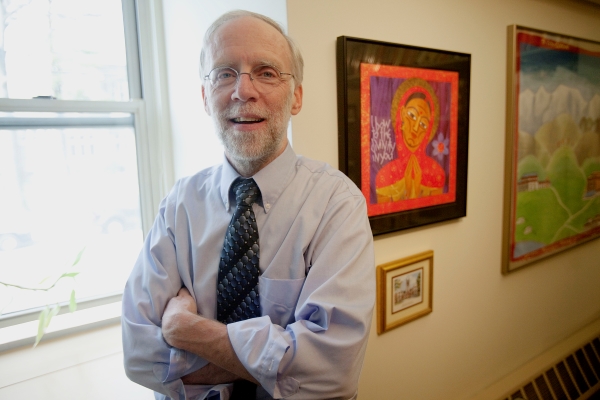
Professor Francis Clooney. Photo from the Harvard Divinity School, by Kris Snibbe, Harvard Gazette.
Francis X. Clooney, a born and bred New Yorker, was following a fairly traditional path toward Jesuit priesthood when he took an unexpected detour that would change his religious and world view forever. Clooney, now Parkman Professor of Divinity at Harvard, is a leading scholar in the Sanskrit and Tamil traditions of Hindu India and the developing field of comparative theology. He has written numerous books, including Hindu God, Christian God (2001) and the more recent Reading the Hindu and Christian Classics (2019). How he found himself at the forefront of Hindu-Christian studies began in 1973 with a trip to Kathmandu, where different religious traditions were not just in books but all around him.
Clooney landed in Nepal at just 22 years old, fresh out of Fordham University with a degree in philosophy and Classics – not uncommon majors for a Jesuit seminarian in training. There, he started teaching at St. Xavier’s, a school founded by the Jesuits in 1950 at the invitation of King Tribhuvan, to gain some practical educational experience of the kind Jesuits were likely to need. Soon, however, he found himself the student, learning more from his teenage Hindu and Buddhist students than he could teach them.
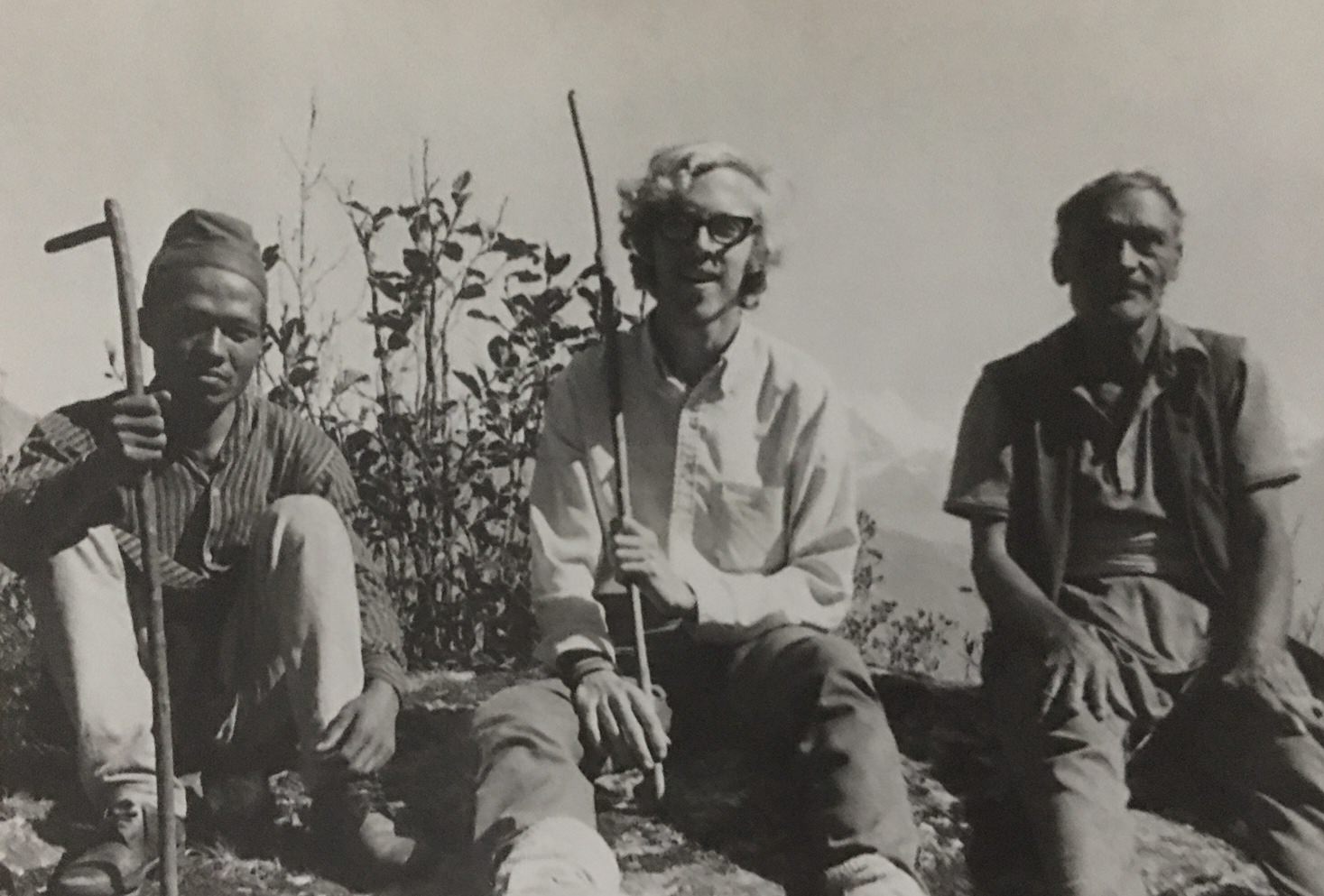
Prof. Clooney in the hills of Nepal in 1974.
The decision to go to Nepal was, in part, driven by the potential connections of Clooney’s Latin and Greek studies to Sanskrit. But the young priest in training was also pulled by something more intuitive. “I had a very simple, instinctive interest in South Asia at that point. I was impressed by Mother Teresa and Mahatma Gandhi, and wanted to be like them, share their experience among the poorest of the poor in some way,” Clooney recalls. But the visa to India would have taken more than a year and he was eager to get going, so he grabbed the opportunity in nearby Kathmandu.
At St. Xavier’s—a boarding school for boys, most of whom were Hindu and Buddhist—he was struck by the rituals and practices of his students and their families, and by the many temples and stupas, festivals, and daily devotions. “There I was, learning not by reading books or studying, but just by being there in the fascinating city of Kathmandu. That was really, for me, the starting experience of seeing the living cultures of Hinduism and Buddhism,” says Clooney. “It turned out to be far more influential in my life than anyone, me included, could have guessed at that point.”
There I was, learning not by reading books or studying, but just by being there in the fascinating city of Kathmandu. That was really, for me, the starting experience of seeing the living cultures of Hinduism and Buddhism.
Clooney returned to the U.S. with an expanded worldview but also new theological interests, thinking theologically outside as well as inside his Catholic tradition. After ordination and a year of Sanskrit study at Harvard with Daniel Ingalls and Gary Tubb, he eventually pursued a Ph.D. in South Asian languages and civilizations at the University of Chicago (1979-1984), studying with some of the University’s leading scholars of Sanskrit and Tamil, a language of South India with rich cultural traditions. During his time at Chicago, a Fulbright fellowship helped him get to India for the first time, to do dissertation work related to Purva Mimamsa, Hindu ritual interpretation. He went to Madras, now Chennai, a southern Indian city where he could test his developing Tamil language skills and dive deeper into ancient Hindu texts, as well as Tamil literature and poetry.
In Chennai, he was connected with a research institute, the Kuppuswami Shastri Research Institute, in Mylapore, the old section of the city. One of his first teachers, a retired principal of the institute, spoke no English, hadn’t dealt seriously with a foreigner before, and was not interested in how an American Ph.D. student might plan his studies; rather, he believed in sitting with a text, reading it, and going on for as long as it takes to understand it. The pundit was, at first, skeptical of the young American, but as Clooney probed with thoughtful questions, the trust opened up and the learning deepened. Clooney’s spoken Tamil and Sanskrit were minimal at the time, but the pundit, in traditional style would sit with him for hours, and Clooney pieced together what he was saying, going back and forth from the book in front of him to his teacher’s lucid explanations.
As the year went on, the teacher could see how committed his student was, and the connection grew deeper and warmer. The pundit’s wife would greet him with biscuits and tea. Before the year was out, teacher and student even shared a most Indian of pastimes: enjoying a cricket match on TV together.
In his spare time, in addition to cycling all over Chennai (as one could still do safely in the 1980s), he was also reading Tamil poetry, the songs of the Vaisnava saints known as the Alvars. “The poetry was beautiful and moving – very different from the rational philosophical Vedanta texts and an added reason to be in South India, which I really enjoyed.” Clooney was able to return to Chennai in 1992-1993 on an AIIS fellowship, to work exclusively on the songs of Nammalvar, the greatest of the Srivaisnava saints, again with learned traditional teachers.
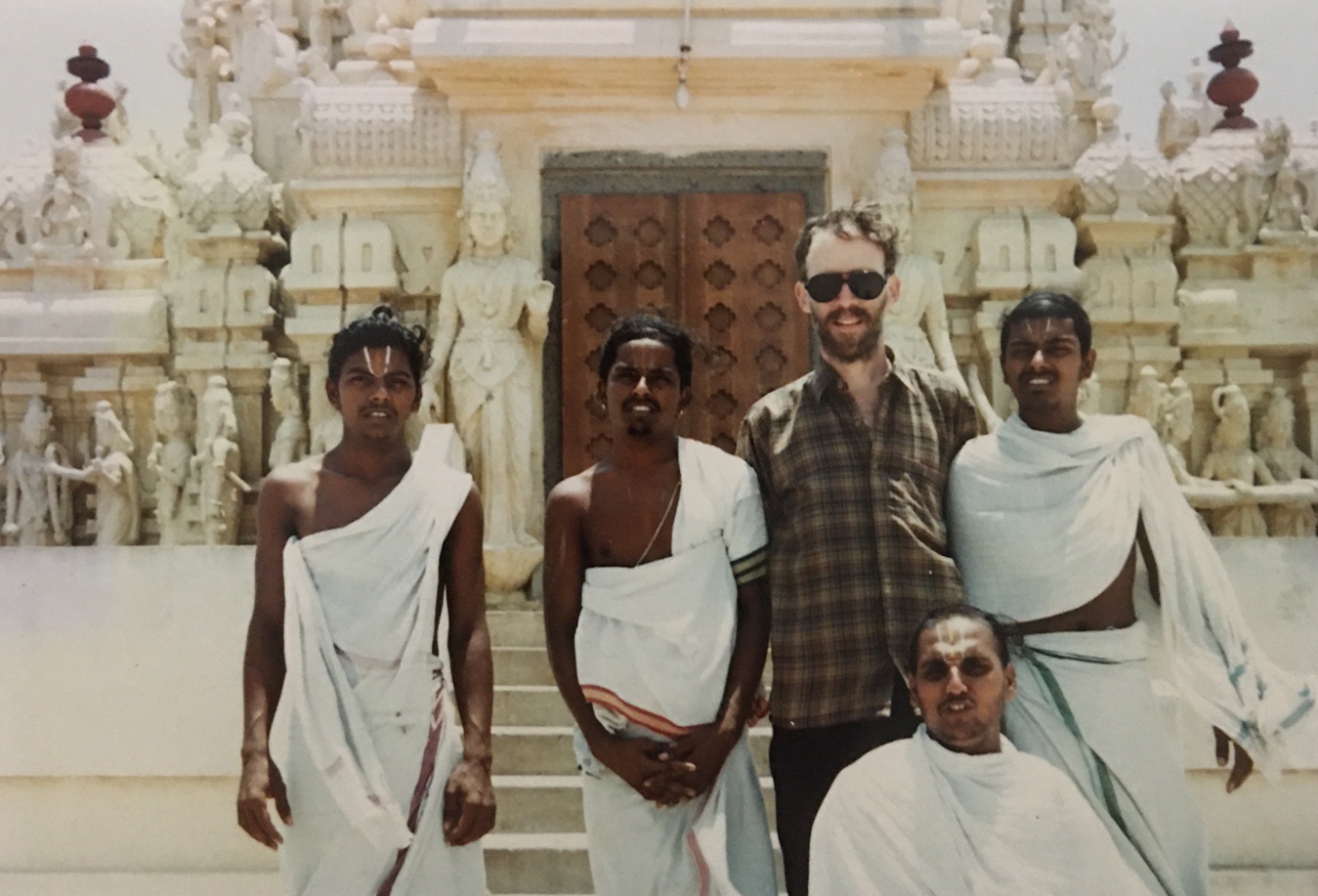
Prof. Clooney at the Astalaksmi Temple, Chennai in 1993.

Prof. Clooney with Sri Sampath Kumaran in 1993.
”Those early experiences have informed Clooney’s personal and professional life to this day, now having completed nearly 40 years of university teaching (at Boston College and, since 2005, at Harvard) and the last 50 years studying Hinduism. In the Divinity School he teaches courses such as “Who Needs God? Rethinking God in Light of Hindu and Christian Theologies” and “Finding God in a Lovely Place: Comparative Theology in a South Indian Context,” and advanced courses on the Upanisads, the Yoga Sutras, and the Bhagavad Gita. He has also continued on Sundays to offer Mass and preach at a Catholic parish in Sharon, MA. His unique path and scholarship will be captured in his new memoir, tentatively titled, Priest and Scholar, Catholic and Hindu: A Love Story, expected to be in print by mid-2024.
It will be a memoir, but without any shocking stories, he jokes. “By the grace of God and with the help from so many teachers and friends over the years, it has all worked out for me, and I’ve been able to hold all these pieces together. By writing this memoir, I want to tell the story in a way that somebody 50 years younger than me might be able to say, ‘Oh, I can do the same thing.’ I guess that’s what it’s about, sharing the wisdom of your years with young people still finding their path.
By writing this memoir, I want to tell the story in a way that somebody 50 years younger than me might be able to say, ‘Oh, I can do the same thing.’ That’s what it’s about, sharing the wisdom of your years with young people still finding their path.
This “love story” with the two religions mingling with one another has given the priest-scholar the ability to see his own tradition in new ways, which, he says, has had a profound impact on him. “Constantly studying these deep rich, mysterious, challenging, religious traditions of Hinduism has always put back on the table for me the possibility of the spiritual, the gracious, the mysterious, the value of ritual, holy places, which in some ways, I think, has kept reminding me of the value of being a spiritual person.” He adds that having multiple religious traditions in his life has not diminished his religious roots—in fact, quite the opposite. “Learning the other doesn’t flatten our original beliefs, it deepens them. It actually gives you a way back home, no matter where your journeys have taken you.”
Learning the other [religion] doesn’t flatten our original beliefs, it deepens them. It actually gives you a way back home, no matter where your journeys have taken you.
Clooney isn’t sure how or why this path happened – he says some have speculated that it was meant to be, given his name is Francis Xavier, the name of the first Jesuit to leave Europe in 1542 for India. But he does know that it was that first sojourn to Nepal 50 years ago that altered the course of his life forever. He reflects on how one small divergent path can have such a profound impact and ponders, for just a moment, of what would have happened had he not gotten on that plane. “It would hopefully have been a good life, but it would be very, very different.”
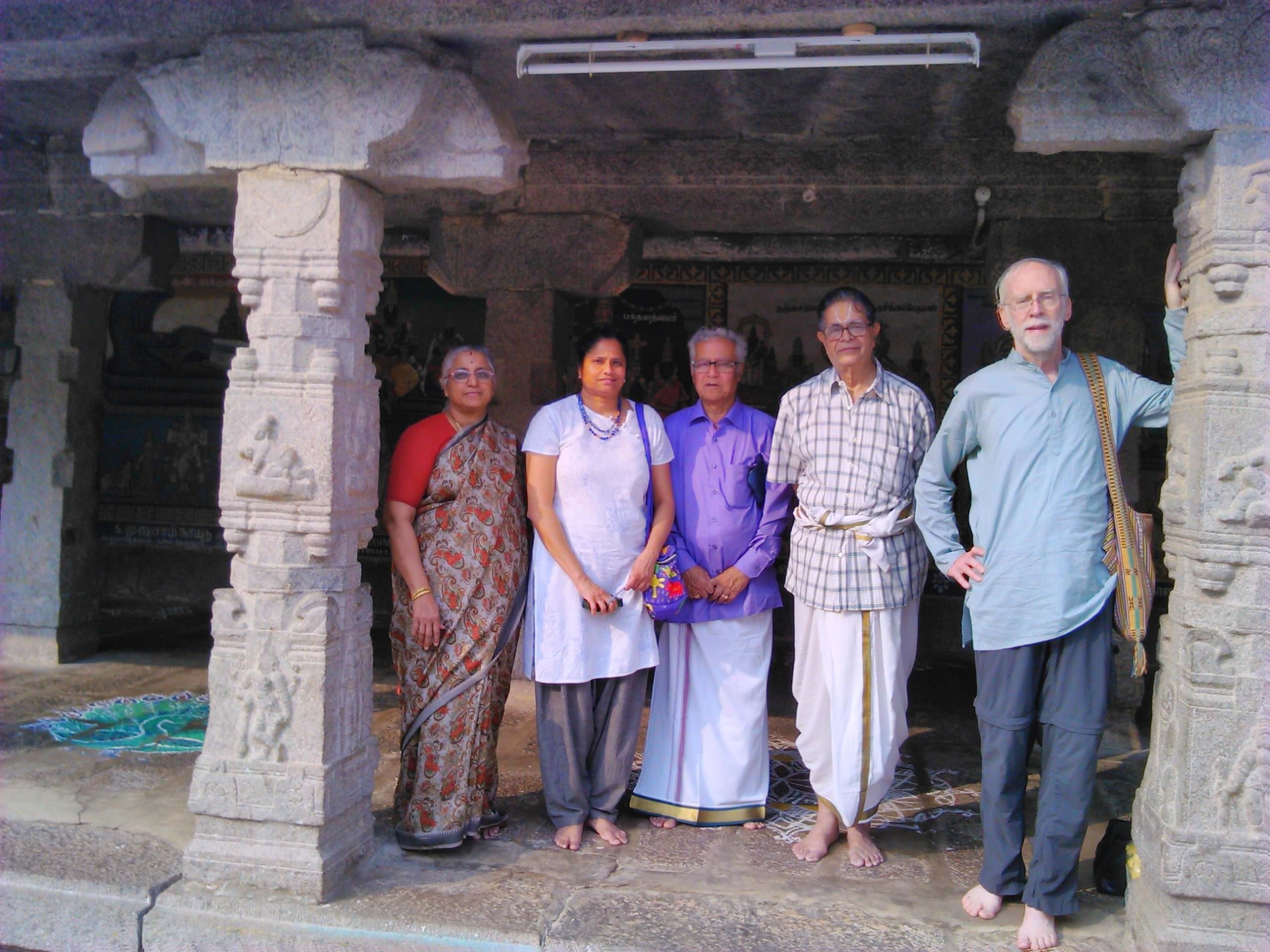
Prof. Clooney (right) at Sriperumbudur Temple in the South Indian state of Tamil Nadu in 2017.
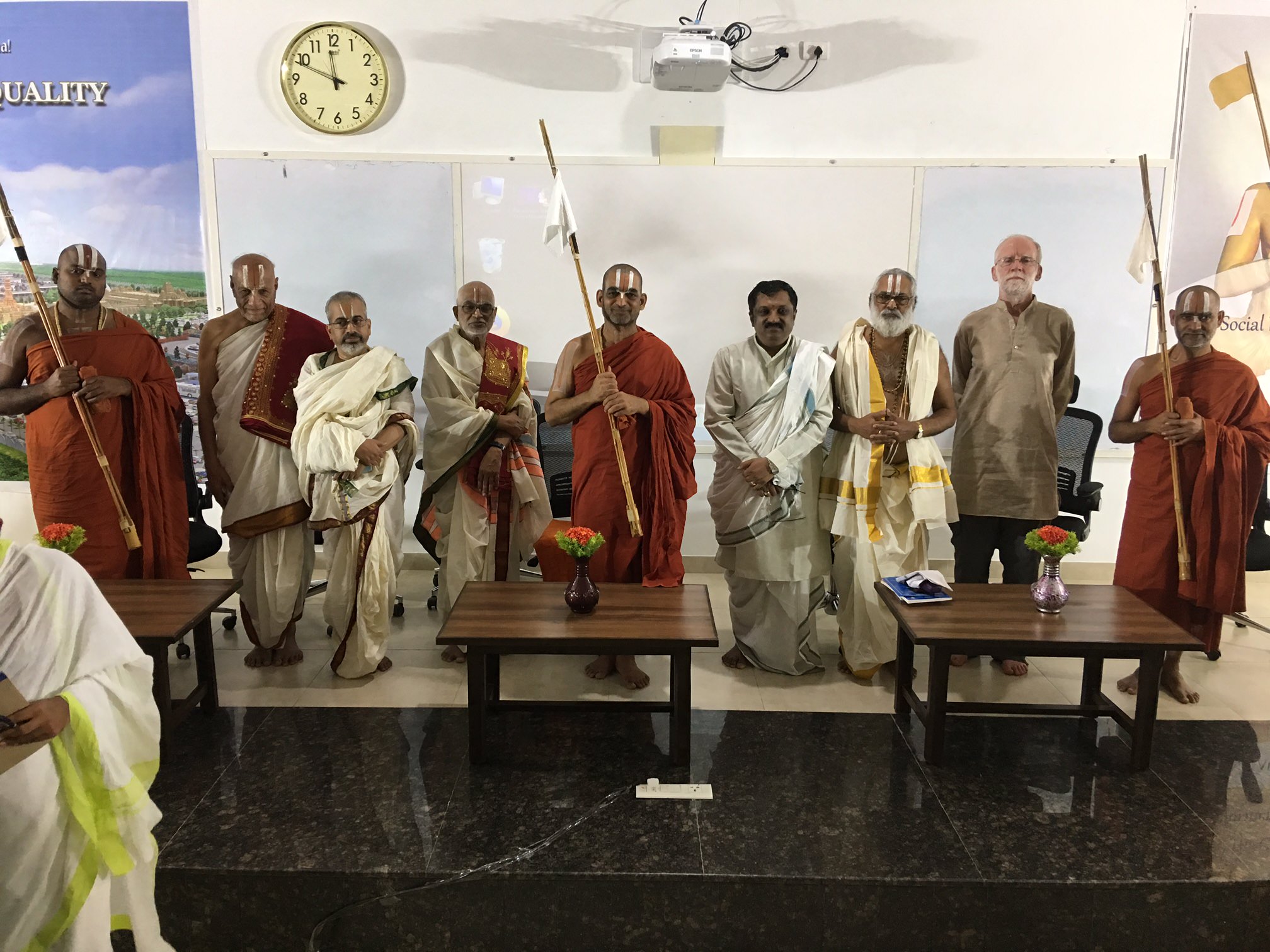
Prof. Clooney at an event at an ashram in Hyderabad.
Prof. Clooney convenes the South Asian Religions Colloquium (SARC) at Harvard, which is open to all. The next speaker will be Ellen Gough (Emory University) on March 23 at 5:30 pm at the Center for the Study of World Religions, 42 Francis Avenue. Her topic is, “Defining the Brahminical Other: The Jain Festival Rakṣābandhana and the Attempted Murder of 700 Monks.”
Read more about Prof. Clooney here, and watch a recent lecture in which he tell his life story in short form here.
This article was written by Carlin Carr, Communications Manager at the Lakshmi Mittal and Family South Asia Institute.
